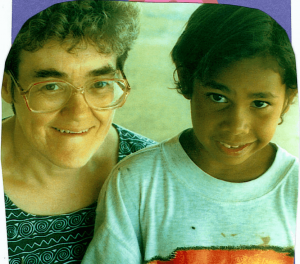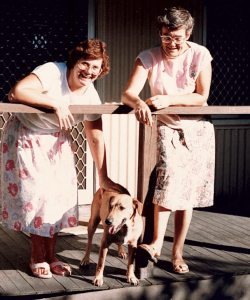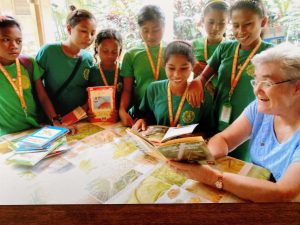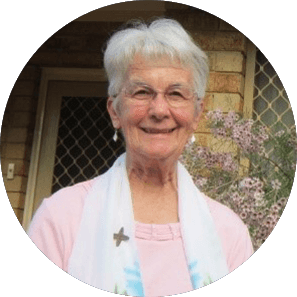I was born in Ashby de la Zouch, England. My parents were Hilda and Edward and I have a sister and two brothers, one of whom died at eleven months. When I was seven, my parents migrated to Australia and we settled in Victoria. Our first home was in Holmesglen and we went to Sacred Heart Primary Oakleigh and it was there that I first met the Sisters of Our Lady of the Missions.
We moved a few times until my parents were able to buy a home in Ashwood. I went to the Juvenate in Fremantle as I felt that I wanted to be a sister. After my Profession I began my missionary journey of teaching in our schools in Western Australia and Victoria. I taught the children in the early classes and I was well rewarded when the children suddenly realised they could read or spell, the look on their faces was a joy to behold. During my time in the different schools, I visited the families in their homes as it was very helpful to know the background of the children I was teaching. I was invited to become the school Chaplain while at Christ Our Holy Redeemer, East Oakleigh, this was a part-time position as I also did Intervention Learning with small groups. While I was Chaplain I ran a grieving programme called ‘Seasons’ for children who had suffered a loss such as losing a parent, grandparent, family member, close friend or even a pet. These sessions were a great source of comfort to the children and they often came back to discuss all kinds of matters with me. I became a holder of many secrets.
I spent three years on the Motor Mission in Lake Grace, Western Australia. We would travel about one thousand kilometres per week going out to the ten centres which were spread far and wide. We ran a Correspondence Course in Religion preparing the children for the Sacraments, we had a Bushie School during the term holidays and the children received intensive lessons and we had lots of fun together. I also did some Adult Education with the Parish Priest and visited the families on the farms in the parish.
I was invited to go to the Kimberley in Western Australia to teach the Indigenous children at Sacred Heart Primary in Beagle Bay. I spent ten years in this beautiful place, the people were friendly and I loved teaching the children and helping to run the school. It was a rewarding time as I learnt much from the old people and the children taught me much about the environment, I could even read the tracks of animals and birds. We enjoyed many festivals, sports days, assemblies and camping out with the children and families.

School Assembly at Beagle Bay – Sr Patricia back right
On one particular occasion the parents and community decided it would be good for everyone at the school to go on a camp. It was talked about with great excitement and it was planned that we go to Middle Lagoon. When the day arrived, the children clambered onto the community truck and so we began our adventure. We were accompanied by parents and the grandmothers. When I arrived, I was surprised to see everyone sweeping the area they had chosen and I asked why they were sweeping the place clean. I was told we had to make sure the area was free of scorpions. Everyone set up camp and then it was off to the beach. It amazed me to see how the older children took care of the smaller ones, no one was ever in danger. Bonny, one of the Nyul elders, came along to take the children in groups to find bush food and bush honey, showing where to find the foods and how to harvest them safely.
While out in the bush Bonny chose a couple of small saplings, which he would use later to carve out boomerangs. After all the children had been out with Bonny, they had lunch after which Bonny sat down and the children gathered around to watch him make a boomerang. He started with a small axe cutting into the wood and giving it shape, he then took a small knife and continued the shaping and finally he took sandpaper to smooth out the wood. He told the children that in the old days they had to scrape the boomerang on the rocks to smooth it out and it took a long time, now we use sandpaper. The Nyul Nyul people did not decorate their boomerangs, they left them plain, they rubbed them with beeswax to preserve them.
After a swim, we had dinner prepared by the grandmothers and after we had eaten one of them came to the staff and said ‘we want the children to pray with us’ we said ‘you go ahead’. They gathered the children together and they all sat around the campfire and said the rosary. As they began, I thought the children will never sit through the whole rosary, but how wrong I was, the children sat attentively, praying the rosary with love and respect from beginning to end and they completed their prayer with a hymn ‘Hail Mary gentle women’ accompanied by Phillip on the guitar.

Sr Patricia with student at Beagle Bay
These wonderful indigenous people taught me so much, I always said they gave me far more than I gave them. I have been left with so many wonderful memories of people who looked out for each other and were always ready to give you a helping hand. The Church was the centre of the community, it was built by the Pallotine Fathers and the people during the first World War and completed in 1918. It is covered with pearl shells and has a bell tower.
While I was there, we celebrated the feast of Pentecost and the people came from all over the Kimberley for a weekend of celebration. On Saturday we had a Sorry Time, Reconciliation. All the people joined in and there was an atmosphere of sorrow and of asking for forgiveness. The next day we had the Eucharist and the people truly took part and at times it was very colourful with dancing and singing in the people’s language. During my time when we had no priest, Bishop Jobst asked me to celebrate a Sunday Liturgy with the people and this was a very meaningful duty for me to be able to do this for the people, they were very grateful. The children joined in by sometimes acting out the gospel and the bishop had asked me to share a reflection on the readings. The people would all receive Communion, they were all so happy to be able to come and pray together and so building up the community.

Sr Patricia (right) on verandah of Beagle Bay house
When I was leaving, one little boy named Anthony gave me a teddy bear. His mother Rosie told me the story. Anthony came to her and asked if he could take his money out of his money box and when she asked why, he said that there was a teddy bear at the shop and he wanted to buy it for Sister Patricia for a present. His mother told him that I wouldn’t want a teddy bear and Anthony told her, Sr. Patricia loves teddy bears she bought us so many and they are in the classroom and she is leaving them there for us kids and she won’t have any, so I thought I’d get her one to keep for herself. His mother was so touched that she said yes, you go and buy the teddy bear for Sister. I still have that bear and I treasure it and when I put it on my bed each morning, I pray for all indigenous people of our country especially the children.
On my return to Perth, I was given the opportunity to teach children with special needs and I taught children with down syndrome and those high on the spectrum of Autism. How I enjoyed the day Mikaela, a down syndrome child, began to read, she read about three lines. She was so happy she ran to the classroom shouting at the top of her voice ‘I can read, I can read.’ She received a big clap from everyone and some shouted ‘good on you Mikaela.’ I can still see the huge smile on her face – it was so good to set her on the road of learning and discovery.

Sr Patricia sharing reading books with the Menubo girls in the Philippines
Another rich teaching experience I had was to go to Kulaman in the southern Philippines to help the teachers learn how to teach English. We spent three weekends together, developing their skills and resources. I also spent time with the Menubo girls who were also learning English – again the joy was in their faces as they overcame the difficulties of learning English.
It has been the joy of my life to give so many children the power to learn.


